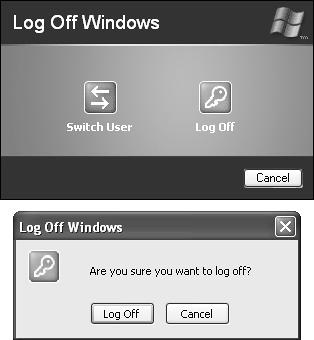Start→Log Off
This command is at the heart of Windows XP’s accounts feature, in which each person who uses this PC gets to see his own desktop picture, email account, files, and so on (see Chapter 17). When you’re logged into a network domain this is one of the most important features of all. You should log off your computer any time you walk away from it, especially if your computer stores confidential information. If this is a home computer and it doesn’t store confidential information you can safely ignore this option forever.
Choosing this command may present either of two dialog boxes, depending on whether your computer is logged into a network domain, or whether or not you log on to a standalone or workgroup computer that has the Windows XP feature called Fast User Switching turned on.
Note
You cannot use Fast User Switching on a computer that logs on to a network domain.
Immediate log off. If you see the dialog box shown at bottom in Figure 2-5, two possibilities exist. The first is that you’re logged into a network domain. When you click Log Off (or press Enter), Windows closes all open programs and then presents the classic Welcome to Windows dialog box so that the next person can log on.

Figure 2-5. Top: On workgroup computers, if Fast User Switching is turned on, this is what you see when you choose Start→Log Off. No matter which button you click, you return to the Welcome ...
Get Windows XP Professional: The Missing Manual now with the O’Reilly learning platform.
O’Reilly members experience books, live events, courses curated by job role, and more from O’Reilly and nearly 200 top publishers.

